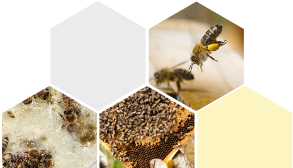DECODING THE WAGGLE DANCE
PEEK INSIDE THE HIVE WITH COMPUTER VISION
When you think of honeybees, you might envision them happily buzzing from flower to flower or busily working inside a hive. But did you know that honeybees can dance? Not fancy ballroom dancing or ballet. Not tap or the tango. Rather, honeybees have choreographed their own unique dance that scientists call the waggle dance.
While the bees perform the dance in a figure-eight pattern inside the hive, their movements communicate the location of nectar sources to the rest of the colony. The speed and direction of the dance movements convey what direction to fly, how far to fly and how rich the food source is.
Knowledgeable beekeepers know how to interpret the dance of an individual bee. But computer vision and real-time analysis of an entire hive full of bees could tell us even more.
THE BUZZWORTHY PROJECT
With bee populations on the decline around the world, Amesto NextBridge partnered with Beefutures in Norway to answer the question: Can we use computer vision to interpret the waggle dance and maximize bees’ access to food?
Christophe Brod, CEO and Founder, Beefutures.
Computer vision extracts directionality and length of a bee’s movement.
Beekeepers try to place hives in a location where bees will find nectar.
Silje Nord, Data Scientist, Amesto NextBridge.
“Usually you film [the waggle dance] with a timer, and you go back home and decode it manually. When you do that type of work, you just capture a few bee waggle dances,” says Christophe Brod, CEO and founder of Beefutures. “What we think the Beefutures approach will bring is the systematic and continuous real-time monitoring of all the bee waggle dances.”
Beefutures created an observation hive filled with sensors, microphones and cameras monitoring the inside and outside of beehives. It quickly captured bee activity using computer vision and streamed the data with IoT technologies. Using algorithms to analyze the real-time monitoring of all the bees in the hive, the team decoded the bees’ movements and located the best possible placement for future hives.
Next, the team developed an interactive map of optimal hive locations that beekeepers can access from their phones. This information helps the beekeepers decide where to relocate hives to optimize conditions or where to plant new food sources based on the time of year.
With just one question and an overwhelming passion for sustainability, this team uncovered a wealth of new answers provided by the bees.
Advanced monitoring of the waggle dances allows bees to act as sensors for their ecosystems. By understanding their dance movements, researchers might uncover even more insights to help save and protect their population, which ultimately benefits us all.
“That’s one of the exciting things here,” says Silje Nord, a data scientist at Amesto NextBridge. “We may provide our way of decoding the dance back to academia and they may use it in future research to see if there are other things we can learn from the bees that we are unaware of now.”
“Hard work and scientific experience combined with creativity and dedication can lead to world-changing solutions for the greater good.”
Kjetil Kalager, lead of the Amesto NextBridge and Beefutures team
RECOMMENDED FOR YOU
NATURE
CITIZEN SCIENTISTS, PREPARE TO SAVE THE WORLD
No matter where you are right now, you are just a click away from helping conservationists identify threats to the Amazon rainforest. Participate in building a computer vision model by exploring satellite imagery in search of human impact.
NATURE
FOLLOWING IN THEIR FOOTSTEPS
Animal populations of the cheetah, lion, leopard and black rhino are declining at an alarming rate. One organization's innovative use of computer vision and crowdsourcing is changing the landscape of animal monitoring.
Curious about SAS and the analytics that empower organizations everywhere?
